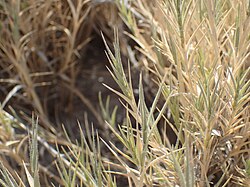Biology:Odyssea paucinervis
| Odyssea paucinervis | |
|---|---|

| |
| Scientific classification | |
| Script error: No such module "Taxobox ranks".: | Plantae |
| Script error: No such module "Taxobox ranks".: | Tracheophytes |
| Script error: No such module "Taxobox ranks".: | Angiosperms |
| Script error: No such module "Taxobox ranks".: | Monocots |
| Script error: No such module "Taxobox ranks".: | Commelinids |
| Script error: No such module "Taxobox ranks".: | Poales |
| Script error: No such module "Taxobox ranks".: | Poaceae |
| Script error: No such module "Taxobox ranks".: | Odyssea |
| Script error: No such module "Taxobox ranks".: | <div style="display:inline" class="script error: no such module "taxobox ranks".">O. paucinervis |
| Binomial name | |
| Odyssea paucinervis (Nees) Stapf [1]
| |
| Synonyms[1] | |
| |
Odyssea paucinervis is a species of African plants in the grass family. The genus is named after the ancient Greek tale the "Odyssey", in allusion to the long journey the type species has taken through nine genera before settling in this one.[2] The specific name means "few veined".
Description
This grass is a perennial plant with long, stout, rhizomes that penetrate deeply into the ground. The stems branch only at the base, have an L-shaped bend and are up to 30 cm (10 in) in length. They grow in matted tufts and are bluish-green. The ligules are formed from rings of hairs and the leaves are rolled, stiff and tough, and somewhat pungent. The inflorescence is narrowly elliptic or elliptic-oblong and up to 7 cm (3 in) long. It is composed of many spikelets, each with four to nine flowers.[3][4]
Distribution
Odyssea paucinervis is native to Zaire, Somalia, Tanzania, Angola, Zambia, Zimbabwe, Botswana, Cape Province, Namibia, Limpopo and Mpumalanga.
Uses
Odyssea paucinervis is a salt-tolerant plant that grows on sand and it is often the only plant in its habitat. The leaves are tough and spiky and are of little use as fodder. The plant has a very deep root system and grows by means of extensive rhizomes. Wind-blown sand builds up around the plants which mat together and form mounds. If planted in dunes this grass can bind the sand and help stabilize the dunes.[2]
References
- ↑ 1.0 1.1 Tropicos, Odyssea paucinervis (Nees) Stapf
- ↑ 2.0 2.1 Stapf, Otto. 1922. Hooker's Icones Plantarum 31: plate 3100 and 3 subsequent text pages
- ↑ Grassbase - The World Online Grass Flora
- ↑ "Odyssea paucinervis". Global Plants. JSTOR. http://plants.jstor.org/compilation/odyssea.paucinervis. Retrieved 22 February 2016.
Wikidata ☰ Q15518922 entry
 |
